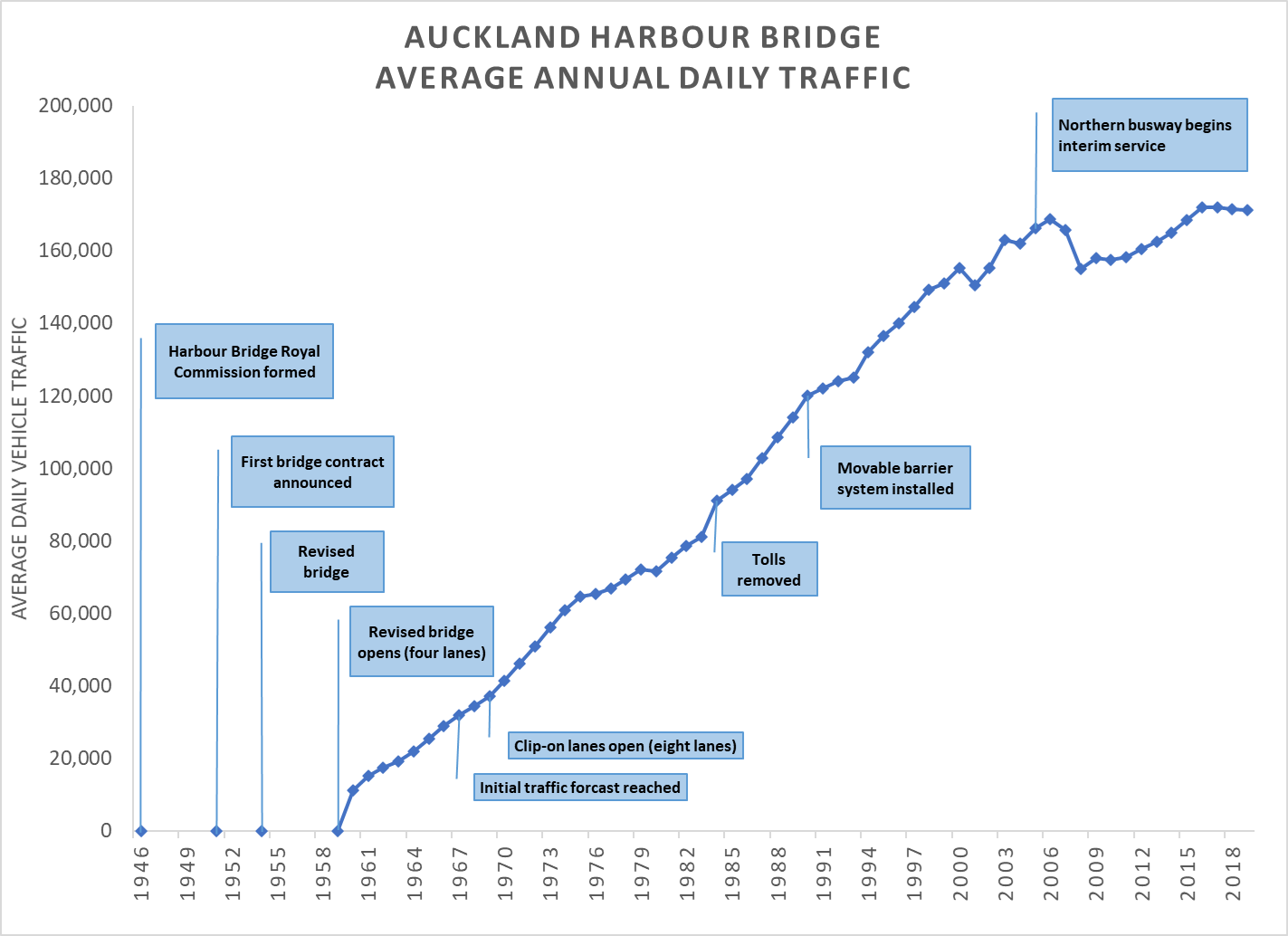The Auckland Harbour Bridge clip-ons, planning disaster… or best practice?
Thu, May 13, 2021 |As most older Aucklanders will know, the Auckland Harbour bridge was originally built in 1959 with four lanes then widened with a pair of ‘clip-ons’ just ten years later. This is often cited as an example of the folly of starting with penny pinching austerity. The history of the bridge is repeated as a rationale for spending ever increasing amounts to ‘do it right the first time’. What good is a cheap narrow bridge if you only have to come back and spend piles of money to widen it a few years later, right?
The ‘penny pinching’ idea
An editorial published by the New Zealand Herald on the 50th anniversary of the Auckland Harbour Bridge sums up this view quite plainly:
“The bridge, itself, serves a ringing testament to another recurring Auckland theme - the peril of short-term thinking and penny-pinching. Various reports in the years after World War II recommended either a four- or six-lane bridge... The Government of the day took fright at the cost and grudgingly settled on an "austerity" bridge of four lanes and no footpaths….Four clip-on lanes had to be added in 1969 in a novel piece of engineering, the cost of which far exceeded what would have been the case for any bridge built a decade earlier with a realistic view of probable demand.”
The problem with this idea is that it’s not actually true!
Despite the common opinion, the staged expansion of the Auckland Harbour Bridge was not only more cost effective overall, but it also actually resulted in a bigger bridge with more capacity, with more development of the city. A win-win outcome for the most part. The tale of the Auckland Harbour Bridge is actually a parable for the opposite of the commonly held view: it shows us the value of transport development programmes with successive expansions of transport capacity and expenditure over time. Let’s walk through what really happened.
The myth of the six lane bridge that never was
This idea that they hamstrung the bridge to save a pittance seems to come partly from mistaken ideas around what was originally planned in the 1950s. Most versions of this myth claim it was supposed to be six motorway lanes (as the NZ Herald repeated), plus a footpath and cycleway, and often a pair of rail tracks or tram lines for good measure. It seems people today think Auckland had originally planned a bridge to rival Sydney famous span, which was then and still is the widest bridge deck in the world!
Indeed it is true that there was lots of talk among the newspapers and the man on the street about these sorts of things. The public dialogue is eerily familiar to the modern ear, there were calls for more lanes from automobile clubs, requests for rail lines from industry, architects demanding tall arches or fancy suspension designs, and an active lobby group that campaigned on ‘tunnel or nothing’ to save the beauty of the harbour. There was also a ferry development strategy worked up as a straw man to prove how expensive it would be to not build a bridge. But apart from the last one, that was all little more than editorial demands and empty opinion pieces.
The reality of the first Auckland Harbour Bridge design (1951)
The reality of the first bridge is much less grandiose that the lore. The original tender for the Auckland Harbour Bridge went out in 1951 with a specification for five general traffic lanes, two footpaths, and a basic low profile arch structure. This would be supported by new roading extensions on reclaimed land running up to Takapuna in the north, and through Saint Mary’s Bay to the city centre.
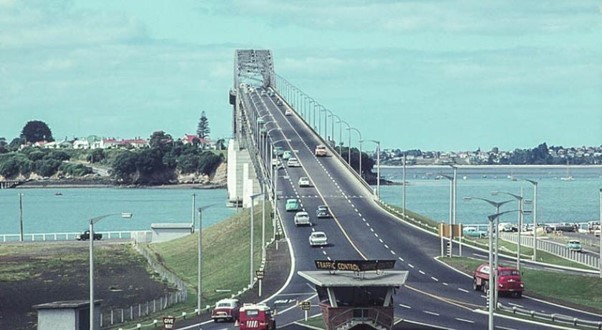
What does this mean for the supposed mark one harbour bridge, well it’s not nearly as super as some might believe. The facts are:
- It had five lanes, not six. In effect a four-lane road with a fifth tidal lane.
- It wasn’t actually a motorway at all. The bridge was designed as an arterial road with a 40 mile an hour speed limit, a shade over 60 km/h. It wasn’t intended to be a motorway. The main highway north was planned to run around the upper harbour, on what eventually became Stage Highway 16 and 18.
- Rail was never seriously considered, not least because it would have required a bridge twice as long to achieve the required grade. Likewise trams were considered obsolete at the time and Auckland had replaced most of them with trolleybuses by the early 1950s.
- Basic footpaths. Although there were two footpaths originally proposed (one each side), at a mere 1.8m wide they’d have been narrower than the footpaths in front of your local dairy.
- No cycle lanes. There is no record of any serious suggestion of dedicated cycle lanes, only footpaths. It’s probable that one of the footpaths might have been allocated to cyclists, like in Sydney, but it wasn’t designed that way. Given the bridge was designed to be a main road, the original designers might have assumed cyclists would ride in the traffic lanes like they did everywhere else in Auckland.
The true costs of early bridge plans and ‘austerity’ bridge that was built (1954-1959)
Right, so winding back from the myth of what might have been we are still left with the idea of penny-pinching up front costing more in the long run. Did they still save pennies only pay pounds later? What does the record show about the actual costs being considered?
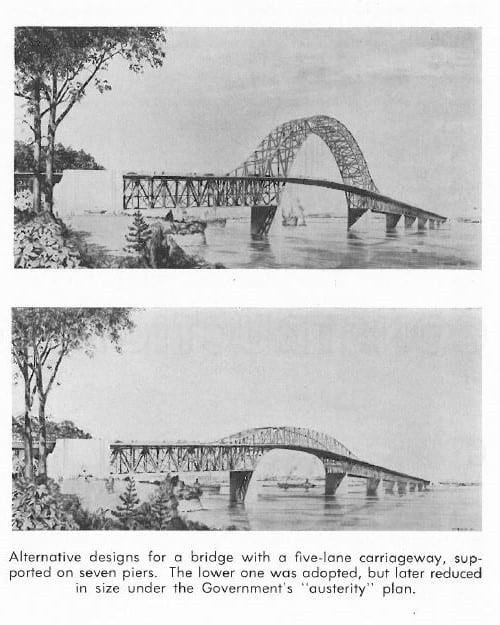
In 1951 the government selected an £8.1 million New Zealand pound tender to build a five-lane bridge with two footpaths. An interesting point was the cost of the bridge proper was less than half of the project: the tender was £3.5 million for the bridge itself, £2.1 million for the approach roads, and £2.5 million for reclamation, property and sundry other costs. This included engineering fees and interest payments for five years while the bridge was being built and before toll revenue would start coming in.
The interest payments are a critical point in this story, as the first bridge scheme was going to be paid for by borrowing on the international market with a plan to borrow in London at 4% interest. While eight million pounds seems like such a small number today, this was such a huge loan back in the day that the prime minister considered it a risk to the national economy. Too great a risk in fact, and he withheld approval for the lending and the project continued to founder.
The reasons for the cost sensitivity around the harbour bridge are quite obvious in retrospect. In the early 1950s Auckland was a small city perched at the top of a small rural economy, and the North Shore was a farming backwater, with a handful of villages at ferry wharves along the harbour edge and holiday baches dotted up the coast.
And here is the critical thing, it was simply a huge project for a small city. At the time, the £8.1 million pound cost was a full 7.5% of Auckland’s annual regional GDP, equivalent to the city spending $7.7 billion dollars today. In relative terms, that would have made the five-lane bridge twice as expensive as any transport project New Zealand has ever undertaken.
In 1954, Prime Minister Holland came back with a new proposition, the whole scheme would be funded locally but the project had to be de-scoped to bring the costs back to earth. This trimmed off the fifth tidal lane and footpaths, giving just four traffic lanes, which saved £771,000 pounds on the bridge structure. Again that doesn’t sound like much, but the equivalent today would be a saving of half a billion dollars. Furthermore, to slash the total budget in half the second scheme also initially dropped approach roads either side. Instead of new reclaimed highways from Takapuna to downtown, the MkII bridge would only have a simple connection to the existing roads either side, with all bridge traffic driving through local streets of Northcote Point and Ponsonby controlled by traffic lights either side. However, after much political wrangling and concern for local traffic issues, modified, narrower versions of the approach roads were put back into the plan.
All in all, the Mark two version of the Auckland Harbour Bridge project, the one that was actually built, eventually cost £7.5m pounds when the deal was signed in 1954. That was down to just 5% off Auckland’s GDP, equivalent to spending $5.1 billion today. The final bridge scheme saved the equivalent of two billion dollars compared to the preferred tender bridge from 1951. This was $0.5b from the cost of building the structure by dropping the fifth lane and footpaths, and a further equivalent of $1.5b from the project by having correspondingly smaller approach roads, less reclamation, and reduced overheads.
But what about the clip-ons? (1969)
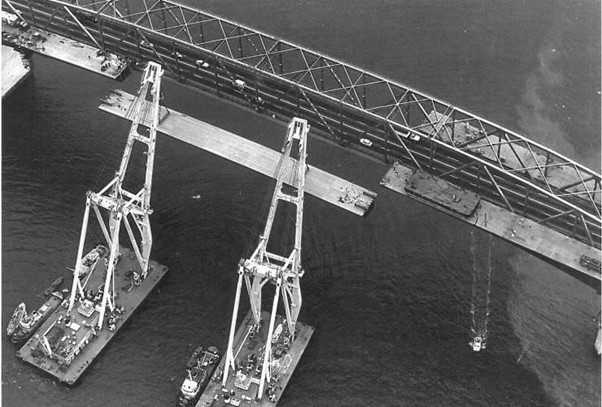
Most Aucklanders are familiar with the ‘Nippon Clippons’, the pair of lanes added either side of the original bridge built by a Japanese company in the sixties. These extra structures, themselves separate bridges, doubled the traffic capacity of the bridge from four lanes to eight when they opened in 1969. Extending a bridge was novel technology at the time, and the price was not exactly cheap. They cost $7.4 million dollars in 1969 (New Zealand having changed from pounds to dollars in the meantime).
This is the bit where people seem to think things went wrong, and at first glance they saved seven hundred thousand pounds on the 1959 bridge only to spend seven million dollars widening it ten years later.
First of all, the comparison is apples and oranges. The initial saving dropped the bridge design from five lanes to four, losing one lane and resulting in 20% less the lane capacity. Meanwhile adding the clip-ons doubled the bridge from four lanes to eight, a 100% increase in capacity. Apples and apples, the comparison is a five-lane bridge in the 50s versus an eight lane bridge in the 60s. Or more to the point, given the cost pressures in the 1950s the real comparison was having no bridge at all. It’s entirely likely that if they had not value engineered the cost of the first Auckland harbour bridge it would have ended up like the 1951 contract and all the other bridge proposals before it, nothing more than an unaffordable set of plans gathering dust in a drawer.
Secondly, the costs of the clip-ons and the ability to pay for them isn’t what they seem. Recall that relative to the Auckland regional economy, the saving they got from a smaller bridge in the 50s was equal to 2.5% of the regional GDP, the equivalent of saving $2 billion dollars today. But by 1969 the population and economy had grown significantly, and the $7.3m spent on the clip-ons was only 0.8% of Auckland’s GDP, the equivalent of spending $800m dollars today.
So in terms of the economy’s ability to pay for the bridge, they saved the equivalent of two billion dollars by dropping the fifth lane, and ten years later spent the equivalent of less than one billion to widen the bridge to a total of eight lanes. That means the eight lane bridge including the added clip-ons was significantly more affordable than a five lane bridge would have been.
Waiting ten years to expand capacity got them four extra lanes for half the fiscal impact of only one extra lane up front!
The outcome: the Auckland Harbour Bridge is a model for future infrastructure development
The reality of the situation is that Auckland actually got a harbour bridge funded, with the contract signed in 1954 and construction finished by 1959. That was far from certain, so the greatest success of the programme was actually delivering a harbour bridge rather than continuing to talk about one.
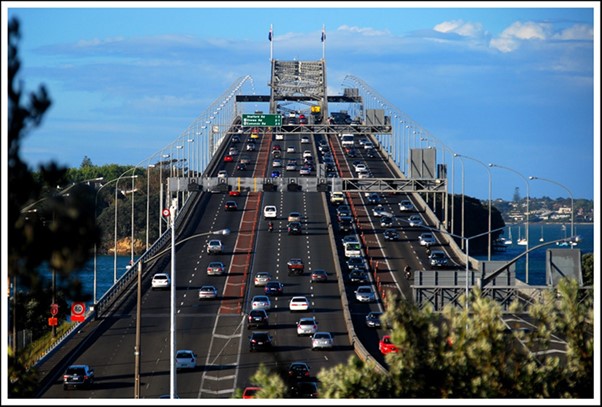
It is certainly true that the bridge was redesigned from five lanes with footpaths to four lanes without footpaths, and in nominal terms this reduced the cost of the project by less than a million seemingly trifling pounds. But in terms of the ability to fund the project, the ‘penny pinching’ that happened between 1951 and 1954 was the equivalent of saving over two billion dollars on a project today. It is what got the bridge built.
Yes, it was expanded from four lanes to eight with the clip-ons, after ten years of growth of the North Shore induced by the first bridge stage started to approach its peak traffic capacity. But far from being a sign of failure this was an economic masterstroke. By leaving this expansion for a decade it was actually easier to fund than if they had built a wider bridge to start with. Ten years of savings on interest payments with a cheaper bridge, combined with the Auckland economy being much bigger after a decade, meant it was much easier to fund adding four lanes of clip-ons in 1969 than was to pay for one more lane in 1959.
So, by the time the loans were paid off in 1984, Auckland had an eight-lane bridge that had been easier to pay for than a five lane one! This shows the value of approaching a programme of staged investment and capacity building rather than trying to do it all up front. To put this in simple terms: don’t borrow extra money up front to build something bigger than you need, years before you need it, because you’ll just be making bigger loan payments that you can’t afford to cover extra interest on something you’re not using yet.
That staged investment has supported a huge increase in transport capacity in parallel to growing population. This has continued over time as the bridge has been upgraded with strengthening in the 1980s, a movable barrier system and electricity and water pipes in the 1990s, and the northern busway in the 2000s. The most lamentable part of this story is that they didn’t re-incorporate the footpaths or a cycleway when the clip-ons were built… but that’s the next stage of development in the Auckland Harbour Bridge story.
